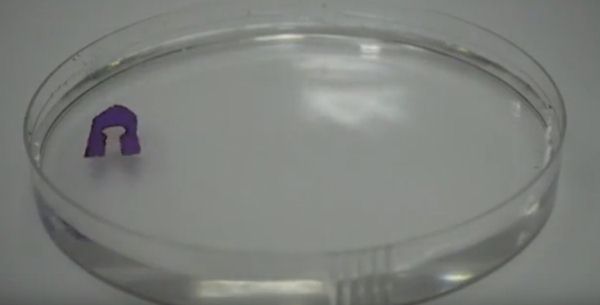|
October
2017 |
|
| The Marangoni Effect | |
|
The easiest way to visualize the Marangoni Effect is to watch the video below. A little paper boat is placed in a vessel of water. A drop of soap is deposited in the middle of the boat. The boat then scoots along the water at a pretty good clip for a number of laps.1
So, how does this happen? It turns out that the liquid soap which is put in the boat is a surfactant - that is, it lowers the surface tension of water. The resulting surface tension gradient causes a force at the rear of the boat where the liquid with a lower surface tension wants to push away. This force continues to propel the boat until eventually the liquid in the vessel reaches a near equilibrium surface tension state - that is, there is no gradient in surface tension - and the boat stops. The force that results between two liquids as a result of a surface tension gradient is explained by the Marangoni Effect - named after the Italian scientist Carlo Marangoni who published his doctoral dissertation at the University of Pavia in 1865 on the topic. The Marangoni Effect can be found in nature. The Rove Beetle, for example, can zip along on a surface of water much like the Water Strider. However, the Rove Beetle can release small amounts of pygidial gland secretions which produces a surface tension gradient and propels the beetle along the surface of water - much like the little boat in the video above. One of the most interesting examples of the Marangoni Effect was actually discovered in space at the International Space Station (ISS)2 where a heat pipe behaved contrary to expectations. On earth when the heating pipes are exposed to a temperature gradient, the inner fluid will evaporate and migrate along the pipe and thus cool the hot end of the pipe. However, at the space station, the opposite behavior was observed. It's posited that without the effects of gravity, the weaker forces caused by the Marangoni Effect resulted in a surface tension gradient that pulled the liquid toward the hot end - the end where the surface tension is nominally lower due to the higher temperature.
The Marangoni Effect can also explain a phenomenon known as the tears of wine (or wine's legs). In the video above, the presenter explains how wine is made of water and alcohol (ethanol). Water has a higher surface tension while ethanol has a higher evaporation rate. When you swish the wine around in the glass, a film results on the inside of the glass. But as the ethanol evaporates, the remaining film's water content increases. Since the water has a higher surface tension, it pulls the wine up the glass into beads at the top of the film. Eventually, gravity takes over and the bead makes a path (called a rivulet) back to the lake of wine below. Warming the glass up, for example, by rubbing it with your hands, will amplify this behavior as the temperature gradient contributes to the surface tension gradient. Wine connoisseurs actually study the rivlets and tears of wine as one of many tools to judge a wine's appearance, texture, structure, body, and quality - which explains why wine glasses are much bigger than the volume they are designed to hold. 1 There are a number of videos that show how to make your own soap boat. This is a lot of fun if you've got some curious kids at home. See https://youtu.be/_nlDVVG0U5M, https://youtu.be/rq55eXGVvis, and https://youtu.be/miWlDVOhrSE for example. 2
Akshay Kundan et al. "Condensation on Highly Superheated Surfaces:
Unstable Thin Films in a Wickless Heat Pipe." Physical Review
Letters. DOI: 10.1103/PhysRevLett.118.094501 |
|
| Product of the Month - Model 500 | |
|
Our Model 500 Advanced Goniometer / Tensiometer represents our largest and most advanced form-factor. With its 21" optical bench and Advanced 3-Axis Stage, Model 500 is capable of accepting every optional accessory that we offer - including some large and heavy components like the Advanced Chamber or 12 inch Rotating Wafer Support.
Model 500 also features our most advanced software package, DROPimage Advanced, capable of contact angle, surface energy, surface and interfacial tension. With the appropriate accessories, Model 500 can also measure surface dilatational elasticity and viscosity, advancing and receding contact angles, roll-off angle, and more. In short, Model 500 is an excellent starting point for any researcher interested in studying wetting properties, surface tension, and other surface characteristics. And with the right accessories, it can be customized to fit any application or requirement. For more information
or to request a quotation, please
contact us today. |
|
|
Regards,
Carl Clegg |
|



